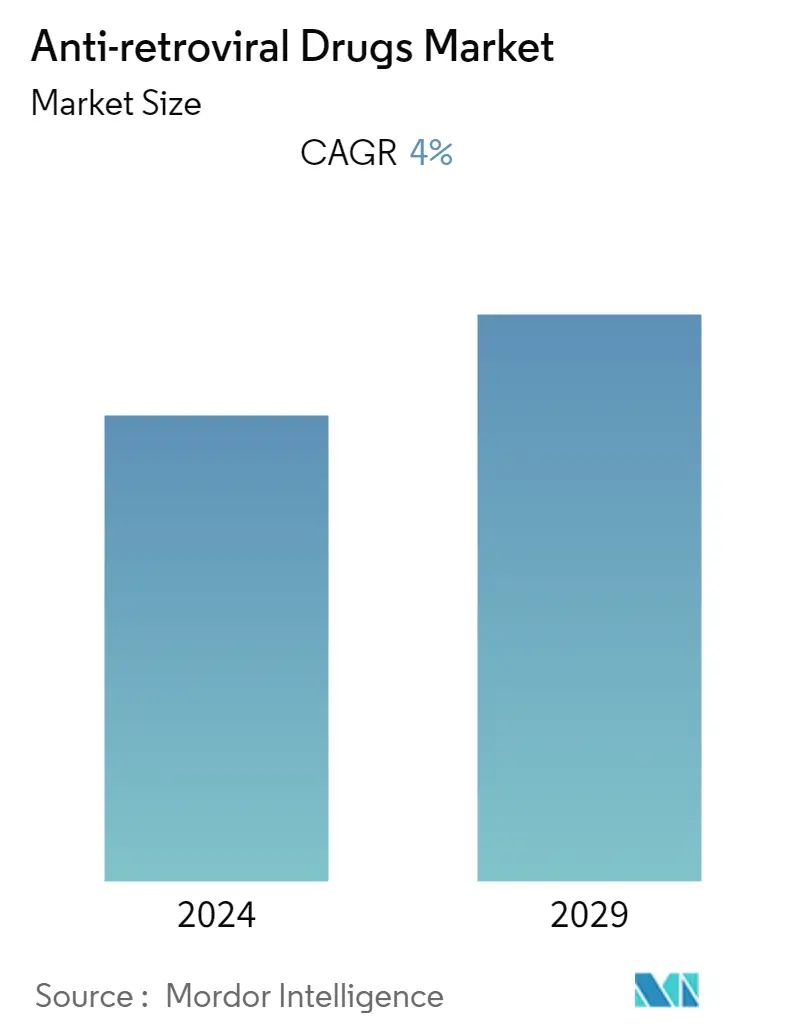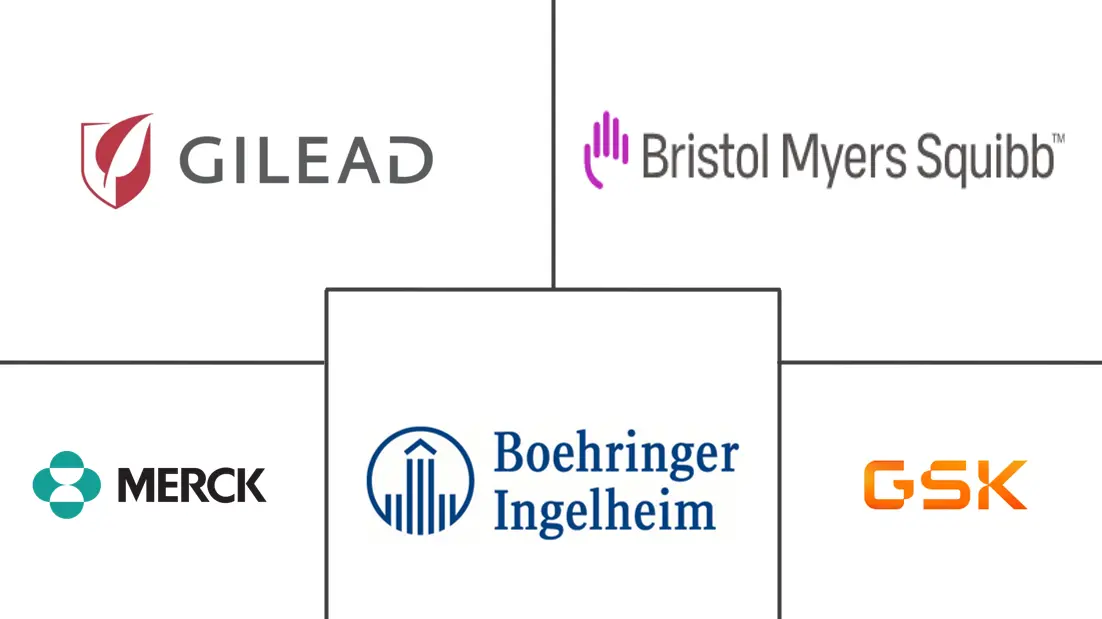Market Size of Anti-retroviral Drugs Industry

| Study Period | 2021 - 2029 |
| Base Year For Estimation | 2023 |
| CAGR | 4.00 % |
| Fastest Growing Market | Asia Pacific |
| Largest Market | North America |
| Market Concentration | Medium |
Major Players
*Disclaimer: Major Players sorted in no particular order |
Anti-Retroviral Drugs Market Analysis
The anti-retroviral drugs market is estimated to register a CAGR of 4.0% over the forecast period.
The COVID-19 pandemic impacted the growth of the anti-retroviral drug market. For instance, an article published by the journal GHSP in December 2021 reported that initially, some of the antiretroviral drugs were largely used for the treatment of COVID-19 and the rising COVID-19 infections surged the demand for these drugs. Thus, increasing COVID-19 cases led to increasing demand for antiretroviral drugs. However, in the current scenario, it is anticipated that a substantial decrease in COVID-19 cases due to the increased vaccination and availability of other drugs for COVID-19 treatment, and the studied market has lost some traction that was gained during the pandemic. However, the studied market is expected to have favorable growth due to the presence of other retrovirus infections over the forecast period of the study.
The factors driving the growth of the studied market are the rising burden of HIV, increasing investment in R&D, and an increase in the availability of novel drugs with better efficacy. For instance, in 2022, India's HIV Estimates Factsheet reported that the annual new infection (ANI) of HIV is estimated at 62.97 thousand in 2021 in India. Similarly, in July 2022 WHO reported that 38.4 million people are living with HIV in the year 2021. WHO also reported that the African region remains most severely affected, with nearly 1 in every 25 adults (3.4%) living with HIV and accounting for more than two-thirds of the people living with HIV worldwide. Also, according to WHO, HIV cases got significantly increased by 32.8% in the last two decades. Thus, rising cases of HIV are increasing the demand for antiretroviral drugs.
Also, the increased R&D expenses by various pharmaceutical companies are driving the growth of the studied market. For instance, in June 2022, GSK reported an investment of EUR 1 billion to accelerate R&D activities for the treatment of infectious diseases that disproportionately impact lower-income countries. The company reported that this research will focus on new and disruptive vaccines and medicines to prevent and treat HIV (through ViiV Healthcare), malaria, tuberculosis, and other infectious diseases, accounting for more than 60% of the disease burden in many lower-income countries. The news also reported that GSK Global Health R&D Hubs are progressing with more than 30 potential new vaccines and medicines, targeting 13 high-burden infectious diseases, including anti-retroviral drug infection. Thus, the increasing R&D expenses are driving the growth of the studied market.
Furthermore, the increasing availability of novel drugs for HIV treatment is driving the growth of the studied market. For instance, in June 2022, Gilead resubmiited new drug application for lenacapavir to the USFDA as a treatment for MDR HIV, lenacapavir is still only in phase 2 studies for treatment. Similarly, in March 2021, Gilead and MSD entered into a new partnership for developing long-acting formulations for the fight against HIV infections. Thus, such development of novel drugs and strategic collaboration between key market players are driving the growth of the studied market.
Thus, the rising burden of HIV, increasing investment in R&D, and availability of novel drugs with better efficacy contributes to the significant growth of the market. However, the side effects of drugs may slow down the growth of the study over the forecast period.
Anti-Retroviral Drugs Industry Segmentation
As per the scope of the report, anti-retroviral drugs are medications for treating infection by retroviruses, primarily HIV. A retrovirus is a group of viruses that belongs to the family Retroviridae, and they characteristically carry their genetic blueprint in the form of ribonucleic acid (RNA). The anti-retroviral drugs hinder the multiplication of these viruses rather than killing them. The Anti-Retroviral Drug Market is Segmented by Drug Class (Protease Inhibitors, Integrase Inhibitors, Multi-class Combination Products, Nucleoside Reverse Transcriptase Inhibitors (NRTIs), Non-Nucleoside Reverse Transcriptase Inhibitors (NNRTIs), and Other Drug Class) and Geography (North America, Europe, Asia-Pacific, Middle East, and Africa, and South America). The market report also covers the estimated market sizes and trends for 17 countries across major regions globally. The report offers the value (in USD million) for the above segments.
| By Drug Class | |
| Protease Inhibitors | |
| Integrase Inhibitors | |
| Multi-class Combination Products | |
| Nucleoside Reverse Transcriptase Inhibitors (NRTIs) | |
| Non-Nucleoside Reverse Transcriptase Inhibitors (NNRTIs) | |
| Other Drug Class |
| Geography | ||||||||
| ||||||||
| ||||||||
| ||||||||
| ||||||||
|
Anti-retroviral Drugs Market Size Summary
The anti-retroviral drugs market is poised for growth, driven by the increasing burden of HIV and significant investments in research and development. The market experienced a temporary boost during the COVID-19 pandemic as some antiretroviral drugs were repurposed for COVID-19 treatment, but this momentum has since stabilized. The ongoing prevalence of retrovirus infections, particularly HIV, continues to fuel demand for these drugs. Pharmaceutical companies are heavily investing in the development of novel drugs with improved efficacy, which is further propelling market expansion. Strategic collaborations and new drug applications, such as those by Gilead and MSD, are also contributing to the market's growth trajectory.
The multiclass combination product segment is expected to see substantial growth due to its effectiveness in treating HIV and the rising number of cases globally. This segment's expansion is supported by new combination therapy approaches and regulatory endorsements, such as those from the UK's National Institute for Health and Care Excellence. North America is anticipated to witness significant market growth, driven by a high number of HIV cases, technological advancements, and ongoing drug approvals. The market remains fragmented, with numerous global and regional players, including AbbVie Inc., Gilead Sciences, Inc., and Merck & Co, Inc., actively participating in the competitive landscape.
Anti-retroviral Drugs Market Size - Table of Contents
-
1. MARKET DYNAMICS
-
1.1 Market Overview
-
1.2 Market Drivers
-
1.2.1 Rising Burden of HIV
-
1.2.2 Increasing Investment in R&D
-
1.2.3 Increase in Availability of Novel Drugs with Better Efficacy
-
-
1.3 Market Restraints
-
1.3.1 Side Effects of Drugs
-
-
1.4 Porter's Five Force Analysis
-
1.4.1 Threat of New Entrants
-
1.4.2 Bargaining Power of Buyers/Consumers
-
1.4.3 Bargaining Power of Suppliers
-
1.4.4 Threat of Substitute Products
-
1.4.5 Intensity of Competitive Rivalry
-
-
-
2. MARKET SEGMENTATION (Market Size by Value - USD million)
-
2.1 By Drug Class
-
2.1.1 Protease Inhibitors
-
2.1.2 Integrase Inhibitors
-
2.1.3 Multi-class Combination Products
-
2.1.4 Nucleoside Reverse Transcriptase Inhibitors (NRTIs)
-
2.1.5 Non-Nucleoside Reverse Transcriptase Inhibitors (NNRTIs)
-
2.1.6 Other Drug Class
-
-
2.2 Geography
-
2.2.1 North America
-
2.2.1.1 United States
-
2.2.1.2 Canada
-
2.2.1.3 Mexico
-
-
2.2.2 Europe
-
2.2.2.1 Germany
-
2.2.2.2 United Kingdom
-
2.2.2.3 France
-
2.2.2.4 Italy
-
2.2.2.5 Spain
-
2.2.2.6 Rest of Europe
-
-
2.2.3 Asia-Pacific
-
2.2.3.1 China
-
2.2.3.2 Japan
-
2.2.3.3 India
-
2.2.3.4 Australia
-
2.2.3.5 South Korea
-
2.2.3.6 Rest of Asia-Pacific
-
-
2.2.4 Middle East and Africa
-
2.2.4.1 GCC
-
2.2.4.2 South Africa
-
2.2.4.3 Rest of Middle East and Africa
-
-
2.2.5 South America
-
2.2.5.1 Brazil
-
2.2.5.2 Argentina
-
2.2.5.3 Rest of South America
-
-
-
Anti-retroviral Drugs Market Size FAQs
What is the current Anti-retroviral Drugs Market size?
The Anti-retroviral Drugs Market is projected to register a CAGR of 4% during the forecast period (2024-2029)
Who are the key players in Anti-retroviral Drugs Market?
Boehringer Ingelheim International GmbH, Bristol-Myers Squibb Company, Gilead Sciences, Inc., Merck & Co, Inc. and GlaxoSmithKline plc (ViiV Healthcare) are the major companies operating in the Anti-retroviral Drugs Market.

